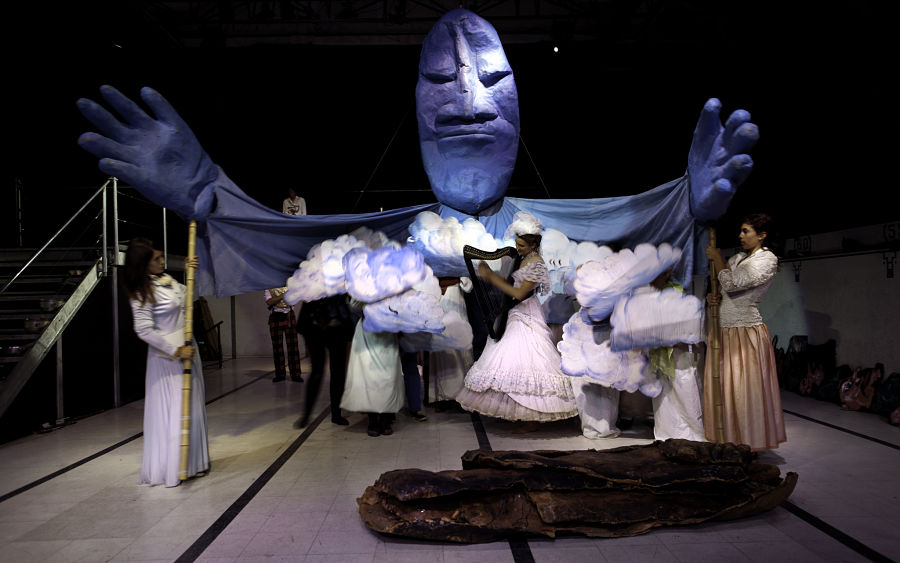The Possibilitarians debuted on June 16, 2012, at the Bread and Puppet Theater, a 30-acre farm and compound in Glover, Vt. It most recently toured to New York City’s Theater for the New City Dec. 6–23, 2012, and will be mounted at the Boston Center for the Arts Jan. 20–27. The show was created, directed and designed by Peter Schumann. The puppeteers are Katherine Nook, Esteli Kitchen, Maryann Colella, Maura Gahan, Gregory Corbino, Noah Harrell, Gabriel Harrell, Rose Friedman, Federica Collina and Lily Lamberta.
Peter Schumann, creation, direction, design: The Possibilitarians goes back to Robert Musil, an Austrian who wrote a book called The Man Without Qualities. In it, he talks about a new type of Austrian person that must be created, and he calls it “the possibilitarian,” a utopian idea. So that’s the source of title. The Possibilitarians reaches all the way from the sky giving birth to Mother Earth to 17th-century England, where there was a poor farmers movement. The farmers claimed the land known as the British Commons and planted potatoes and grain there, only to be eventually driven out. They called themselves diggers and they wrote terrific pamphlets claiming the common land, and we are using those pamphlets in the show. When we first read them, we thought they totally befitted the moment right now in New York City! And we also had Canadians in our group, who told us that it’s exactly what’s happening in Montreal. So it’s a modest play about everything. The whole of history!
It’s also a puppet show in the biggest sense of puppetry. It has 20-foot-tall marionette puppets, 40-foot-tall puppets, animal-shaped puppets and little cardboard diggers. The 20-foot puppet (above) is a marionette, and it flies over the audience, representing the sky in a long, heavenly scene where the sky gives birth to Mother Earth. In the Paradise scene (below), the horizontal puppet that represents Mother Earth is made up of disconnected units—all of her limbs have different demands. They can’t agree with each other so they battle and kill each other. How do human beings begin, other than from one catastrophe to another? Otherwise we wouldn’t promote so much catastrophe.

The puppets are all made of papier-mâché. They get sculpted in clay, which we dig out of the rivers here and mix with hay. Then over the clay mold, we put layers of cardboard that is soaked in water and corn starch, and left to harden in the sun. It’s a process that takes a lot of work and no money whatsoever, so it’s a poor man’s giant theatre. This year is our 50th anniversary, so we are going to be 50 years old.
Not including me, I’m a thousand years old!
Katherine Nook, puppeteer: I started working with Bread and Puppet as a resident company member in May 2011. We pride ourselves in doing a little bit of everything, so I don’t specialize in any particular kind of puppet. The blue puppet (above left) flies over the audience, so there are pulleys attached to the arms, head and dress. The neat thing is learning your role—when to pull and when to let go and what’s the relationship between you and all of the other puppeteers. The Mother Earth puppet (above) is a really beautiful and tricky puppet—there’s a precision in where your piece is, because each body part is separated.
I was one of the cue masters for it—I was cueing the movement via cymbals. The cymbals are used when the puppet pieces break out and move as a Picasso-esque, non-body creature. When the cymbals sound again, the pieces come back and form an abstract sculpture. The Possibilitarians was created because of the work happening in places like Montreal and Pittsburgh, where people are standing up and saying that this industrial agricultural world we’re living in doesn’t work and we need to create a community garden.


